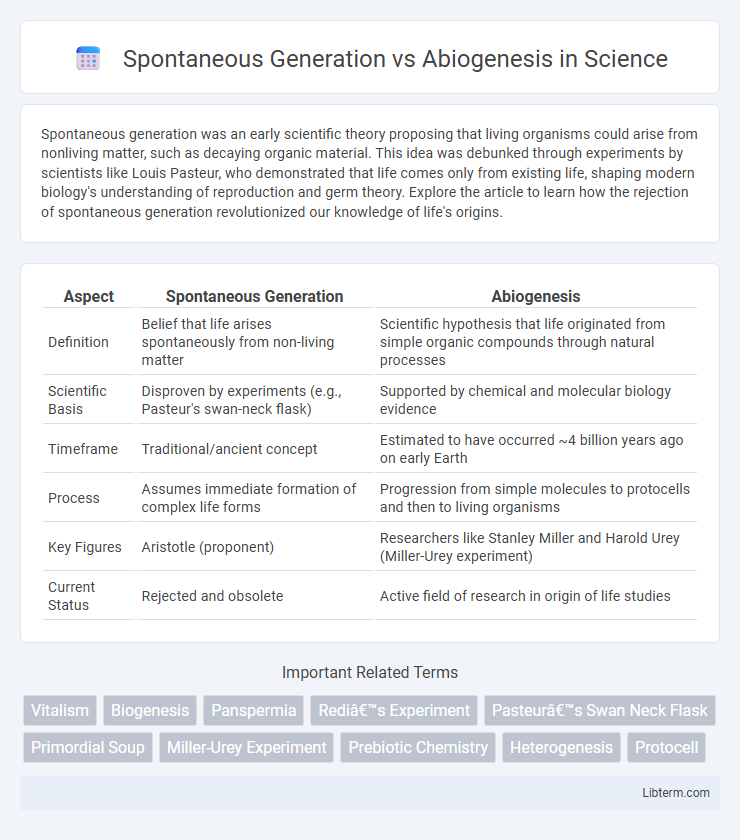Spontaneous generation was an early scientific theory proposing that living organisms could arise from nonliving matter, such as decaying organic material. This idea was debunked through experiments by scientists like Louis Pasteur, who demonstrated that life comes only from existing life, shaping modern biology's understanding of reproduction and germ theory. Explore the article to learn how the rejection of spontaneous generation revolutionized our knowledge of life's origins.
Table of Comparison
| Aspect | Spontaneous Generation | Abiogenesis |
|---|---|---|
| Definition | Belief that life arises spontaneously from non-living matter | Scientific hypothesis that life originated from simple organic compounds through natural processes |
| Scientific Basis | Disproven by experiments (e.g., Pasteur's swan-neck flask) | Supported by chemical and molecular biology evidence |
| Timeframe | Traditional/ancient concept | Estimated to have occurred ~4 billion years ago on early Earth |
| Process | Assumes immediate formation of complex life forms | Progression from simple molecules to protocells and then to living organisms |
| Key Figures | Aristotle (proponent) | Researchers like Stanley Miller and Harold Urey (Miller-Urey experiment) |
| Current Status | Rejected and obsolete | Active field of research in origin of life studies |
Introduction to Life’s Origins
Spontaneous generation, an outdated theory, claimed life could arise suddenly from non-living matter, whereas abiogenesis scientifically explains life's origins through gradual chemical processes on early Earth. Abiogenesis involves the formation of simple organic molecules that evolve into complex self-replicating systems, laying the foundation for biological life. Modern research in origin-of-life studies emphasizes prebiotic chemistry and environmental conditions that facilitated this transition from non-life to life.
Defining Spontaneous Generation
Spontaneous generation is the disproven biological theory that living organisms can arise from nonliving matter without reproduction, such as maggots emerging from decaying meat. This concept dominated scientific thought until the 19th century when experiments by Louis Pasteur demonstrated that life originates from existing life through germ theory. In contrast, abiogenesis refers to the scientific hypothesis that life on Earth began naturally from simple organic compounds through chemical processes over billions of years.
Understanding Abiogenesis
Abiogenesis explains the origin of life through natural processes where simple organic molecules gradually evolved into complex living organisms on early Earth. Scientific evidence supports that life began from non-living chemical compounds in hydrothermal vents or shallow pools, contrasting with the discredited spontaneous generation theory, which suggested life arose from non-living matter instantly. Understanding abiogenesis involves studying prebiotic chemistry, the formation of self-replicating molecules like RNA, and environmental conditions that facilitated the emergence of primitive cells.
Historical Beliefs and Myths
Spontaneous generation, an ancient belief dating back to Aristotle, posited that life could arise from nonliving matter, such as maggots forming from rotting meat. This concept dominated scientific thought until the 17th century when experiments by Francesco Redi and later Louis Pasteur disproved it, paving the way for the modern theory of abiogenesis. Abiogenesis hypothesizes that life originated from simple organic compounds through gradual chemical processes on the early Earth, fundamentally shifting understanding from myth to scientific inquiry.
Key Experiments Debunking Spontaneous Generation
Louis Pasteur's swan-neck flask experiment in 1861 provided critical evidence against spontaneous generation by demonstrating that sterilized broth remained free of microbial life unless exposed to contaminated air. Francesco Redi's mid-17th century experiments with meat and maggots showed that larvae only appeared when flies had direct access, disproving the idea that maggots spontaneously arose from decaying flesh. John Tyndall's repeated sterilization experiments further supported Pasteur's findings by proving that microscopic life forms could be eradicated with sufficient heat, reinforcing the principle that life arises from existing life in abiogenesis.
Scientific Foundations of Abiogenesis
Abiogenesis is grounded in scientific principles demonstrating the natural emergence of life from non-living chemical compounds under prebiotic Earth conditions. Extensive research into molecular biology, chemistry, and geophysics supports this theory, highlighting processes such as the formation of amino acids, nucleotides, and self-replicating RNA molecules. Laboratory experiments like the Miller-Urey experiment provide empirical evidence by simulating early Earth environments and generating organic molecules essential for life.
Major Figures in the Origin of Life Debate
Francesco Redi challenged Spontaneous Generation by demonstrating through controlled experiments that maggots on meat came from fly eggs, not spontaneous formation. Louis Pasteur further refuted Spontaneous Generation with his swan-neck flask experiments, proving that microorganisms arise from existing microbes rather than spontaneously. Alexander Oparin and J.B.S. Haldane contributed to Abiogenesis theory by proposing that life originated from simple organic compounds in Earth's early reducing atmosphere through chemical evolution.
Modern Evidence Supporting Abiogenesis
Modern evidence supporting abiogenesis includes experiments like the Miller-Urey experiment, which simulated early Earth conditions and produced amino acids, the building blocks of life. Discoveries of extremophiles thriving in harsh environments reinforce the possibility that life originated from simple organic compounds through natural chemical processes. Advances in molecular biology and genetics reveal that complex biomolecules can form spontaneously, supporting the transition from non-living chemistry to living organisms.
Impact on Biology and Evolutionary Theory
Spontaneous generation, the outdated belief that life arises from non-living matter instantaneously, hindered early biological research by promoting misconceptions about organism origins. In contrast, abiogenesis provides a scientific framework explaining life's gradual emergence from simple molecules through natural processes, shaping modern biology and evolutionary theory. This shift guided the understanding of life's complexity, supporting evolutionary mechanisms and fostering advancements in molecular biology and genetics.
Conclusion: The Legacy of the Debate
The legacy of the spontaneous generation versus abiogenesis debate lies in its profound impact on scientific understanding of life's origins, transitioning from myth to empirical study. Experimental evidence, such as Louis Pasteur's work disproving spontaneous generation, established a foundation for modern biology and the study of chemical evolution. This debate propelled advancements in microbiology and biochemistry, shaping contemporary hypotheses about how life emerged from non-living matter through natural processes.
Spontaneous Generation Infographic

 libterm.com
libterm.com